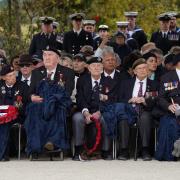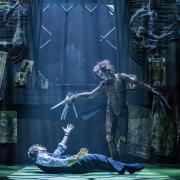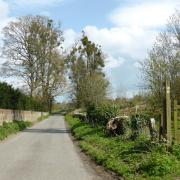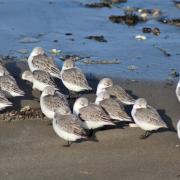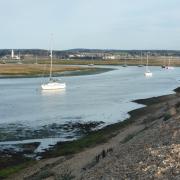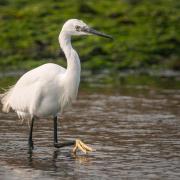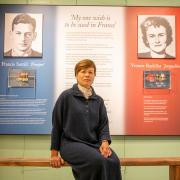Charlie Barton, sister in law to Andrew Lloyd Weber and renowned artist blew the brains of our art writer Sandra Smith with her stratospheric style
When I first arranged to interview Charlie Barton, an initial glance at her website revealed a collection of captivating paintings. The vibrancy of her canvases, strong both in tone and subject generate appealing images and I eagerly anticipated meeting the artist.
Closer to our appointment, however, I suffer a frisson of intimidation. For having delved a little deeper into her work, I discover influences - evolving universe, decomposition and interconnectedness of matter – which are surely more akin to science than art. It was at that point I braced myself for a morning of intimidating dialogue.
How wrong could I have been? After driving through Hampshire’s well tended countryside, I wasn’t long in Charlie’s company before berating myself for such misjudgement.
“My day starts at 5.15am,” she reveals while welcoming me to her light and airy studio. “I ride a couple of race horses for the trainer, Hughie Morrison. It’s a lovely way to start the day. Horses are part of my heritage and it’s good for my head to do something active, outside, and to have conversation. I’m usually in my studio by 10.30ish and stay here for eight hours.”
The diminutive artist insists on offering me a variety of drinks and tempting biscuits before allocating me the only clean chair. Then she settles herself on a paint splattered seat in the middle of a chaotic work space where, surrounded by canvases and materials, we discuss her vocation.
Given her obvious pleasure of outdoor life and animals – she shares her cottage with Slipper, an Irish Terrier, and a cat called Mrs Chippy, named after the feline which accompanied Shackleton on his Antarctic expedition – I start by questioning the appeal of the cosmos.
“Early in my first year at art school my father became ill. By the time he died I had become interested in Buddhist philosophy and I was also reading Capra, a physicist interested in contemporary science and eastern philosophy. My style evolved from there.”
I’m already enjoying the reflective character of this engaging artist as she continues: “Joseph Beuys, a conceptual artist of the 1960s, was a big influence. I loved his ideas and the materials he worked with. He was one of the first to be nature aware and I liked his connection with the earth.”
Describing her work as elemental and primordial is no longer as inaccessible as I’d originally thought. Charlie has a fascination for the genesis of life, an appreciation of connecting with our planet as well as a respect for nature. Her passion is tangible and it’s easy to appreciate the enthusiasm she channels into her work.
“I’m interested in ideas about matter and energy,” she explains, revelling in her comfort zone. “This comes from thinking about death and therefore life and the idea that we’re in a constant state of recycling material, whether ourselves or everything in nature.”
It’s a long way from school art classes when her disdain for still life was met with an air of disapproval. “My teacher and I weren’t on the same wave length,” Charlie smiles. “I needed to be more expressive but was always being told off.”
Such opposition was clearly no deterrent, for she went on to complete a BA Hons Degree in Fine Art. While building her portfolio over the following years she took on a number of jobs including waitressing and secretarial work, using any spare time to paint. Her first sale went to James Mullen, one of the founders of Thomas Pink, the high end shirt retail business. This painting, you won’t be surprised to learn, featured a magma flow. Its memory triggers a familiar fascination: “I started with the idea of using the body as a vessel and focused on regeneration and degeneration. I had no idea what to charge,” she recalls, “I think I just plucked a figure from the top of my head!”
Charlie works intuitively. Introducing an element of planning results in a loss of creative impetus though she confesses there’s a fine line between keeping hold of ideas and simultaneously allowing a painting to evolve.
A number of her Matter and Energy compositions are positioned around the studio while one of her works in progress, Venus, rests on an easel beside us. I’m drawn to its irregular consistency. In fact, to be honest, there’s nothing I’d like more than to run my hands across the enticingly uneven surface.
Charlie senses my attraction. “I reproduced Venus after seeing a photo. I poured alkoflow onto the canvas and added colour. It’s a random, but at the same time controlled, process. Water or turpentine breaks up the medium and this is what creates the crater like effect. After drying I interfere with it more. A skin forms in places and the resulting texture and depth give it a three dimensional quality.”
The effect is a far more interesting representation than any other painting I’ve witnessed. And the density of orange hues aptly portrays the hottest planet in our solar system. No wonder this artist describes herself as a sculptor who paints. Perhaps this is a leaning inherited from her father who made toys for his daughters. Both practical and a perfectionist, he was not remotely interested in the arts yet exuded a creative disposition.
Although the subjects of her paintings aren’t connected with Hampshire, Charlie recognises the inspiration, on a subliminal level, which she draws from the county.
“The landscape is beautiful and I love to see the changing seasons. I feel I have lots of head space and I’m very blessed to live here.”
Home is nearby where her sister and brother-in-law, Andrew Lloyd Webber, are neighbours. So does the country’s most prolific composer support her work?
“Andrew understands the creative process so he’s a good person to talk to. He’s obsessed with the Pre Raphaelites but always comes to my exhibitions.” These shows are an important aspect of any artist’s life, of course, though I don’t believe such public exposure comes naturally to my interviewee.
“I like to meet my public but it is daunting, the idea of a solo show is very exposing. Yet positive feedback is affirming and I sell a lot of pieces this way.”
Like many creative types Charlie is never satisfied with her own work; only when pushed does she admit to a smattering of pride when a recent client, having purchased a painting, sent her a photograph of it in situ endorsing the pleasure it projects.
“There’s so much more I’d like to do,” she adds, confirming that ambition features strongly on her agenda. “I want to have the freedom to explore creatively and push boundaries. Maybe even collaborate with someone on a photographic project.”
During the last couple of hours I have so enjoyed debating the challenges of creativity, I could happily bask in Charlie’s company all afternoon. My deadlines and her commissions, however, must take priority. But first, amid profuse but unnecessary apologies for not providing me with lunch, Charlie extends an invitation to her next exhibition, which I gratefully accept. Then I leave, with an enlightened view about the influence of science not only on art in general, but more importantly on this personable and unique artist.






